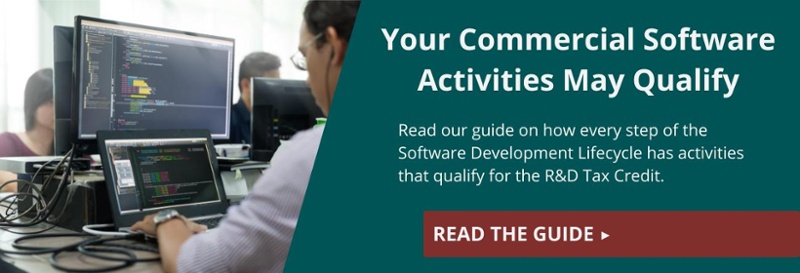
The software industry is well-suited to take advantage of the R&D Tax Credit. There are endless opportunities within this continually evolving field to develop new and/or improved products and processes. After all, to stay competitive, you need to innovate with new and better solutions.
Innovation requires significant analysis, design, building, and testing, especially in the area of software development. The good news is, the costs of this innovation can be offset, because many of the activities required to enhance and develop new software clearly qualify for the R&D Tax Credit. The credit can have a significant impact on a company’s bottom line - By reinvesting the credit back into the business you can be more competitive, grow faster and make more money.
Software Development Lifecycle
There are many phases of a project in which research and development happens. It begins in the initial planning stages and continues all the way through the software implementation (and even beyond).
Software development typically happens in seven main phases, often called the software development lifecycle. One of our previous blog posts highlighted all seven phases of the software development lifecycle in order to show the range of qualifying expenses. This blog will focus in on specific activities within phase six: implementation.
Software Implementation
The 6th phase, implementation, begins when the code has been written and fully tested. The application is then put into production by moving the data and programs from the previous system into the new one via a direct cutover. Or, in the case of a new implementation or establishment of a new instance, the entire application is moved into the new environment. Provided all the careful planning and preparation to get to this point pay off as expected, the system should now be available for operational use.
All activities involved in getting the programs and environment ready for implementation/production use likely qualify for the credit. A few general areas are:
- Environment set-up
- Data conversion
- Code deployment
- Security
- Monitoring and maintenance utilities
Activities that typically don’t qualify are:
- Writing user documentation
- User training
Any difficulty with the system at this point could result in the need for more research and development to understand the problem and come up with potential solutions. This may even require going back to a previous phase. In each case, the additional research and development required could also qualify for the R&D Tax Credit.
Companies seeking to benefit from this tax credit should carefully document all activities in order to create a full picture of which activities qualify and to receive the biggest benefit.
The Four-Part Test
Once you’ve identified potential qualifying activities, run them through the four-part test to verify. The four parts of the test are:
- Permitted Purpose. This is the activity intended to make or improve either a product or process that results in improved function, performance, reliability, quality or cost efficiency.
- Technical Uncertainty. This is the activity intended to eliminate technical uncertainty when developing or improving a product or process related to methodology, design, techniques, formulas or inventions.
- Process of Experimentation. This is the activity that includes a process of experimentation to eliminate or resolve technical uncertainty. During the process, various alternatives and approaches are evaluated by modeling, simulation, trial and error, prototyping and other methods.
- Technological in Nature. The process of experimentation must rely on the hard sciences (engineering, physics, biology, chemistry, computer science).
Applying for the R&D Tax Credit can be a complex process. Consult with an R&D Tax professional for advice and information on how a software development project could qualify for the R&D Tax Credit.





